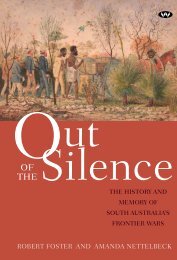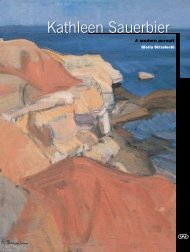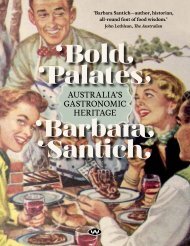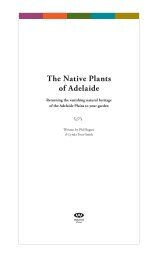bruce munday - Wakefield Press
bruce munday - Wakefield Press
bruce munday - Wakefield Press
- No tags were found...
Create successful ePaper yourself
Turn your PDF publications into a flip-book with our unique Google optimized e-Paper software.
Before fences – shepherdsAny party in want of a shepherd who holds good testimonials of character and has had twelveyears experience in the employment of one of the most extensive Sheep farmers in Scotland,may have the immediate services of the advertiser by applying at the Immigration depot onMonday next or the following days. – Register, 16 May 1840European conquest of much of South Australia was rooted in the principle of ‘first in best dressed’.Vast pastoral runs based on occupational licences were set up by men with vision for what mightbe and with the capital to stock them.Until the 1850s there were few fences on the pastoral runs; livestock was controlled by shepherdsand boundary riders. By the early 1850s Bungaree Station north of Clare had fifty-two shepherds forapproximately 100,000 sheep. The going rate was between ten and fifteen shillings per week withouta hut keeper, along with weekly rations of meat, flour, sugar, and tea.Shepherding was generally near the bottom of the vocational ladder, shepherds in some regionsearning little more than their keep and their abode reflecting their low station. Responding to anassertion that shepherds were getting a bit cheeky seeking a pay rise to above fifteen shillings aweek, a correspondent defended the claim in the Adelaide Observer, noting that shepherds weresometimes referred to as ‘hutters’:He takes charge of a flock of sheep day and night, living by himself, cooking for himself, infact living – no, existing – like a hermit, seldom seeing any of his race or colour. His lodgingsconsist of anything in the shape of a hut, and his ‘board’ shepherd’s rations, viz. flour, meat,tea and sugar – ‘only this and nothing more.’ * Living such a life as this, in addition to the riskhe runs of having his lonely hut plundered of his few traps by some marauding white or blackfellow, is it a wonder that such a man should expect 20/- (a week) for his services? 2Nonetheless, there is today a perception that shepherding was something of a pastoral idyll. If youwere content with a solitary life, generally free of pressure and physical exertion, shepherdingwas not such a bad option. The reality was probably rather different, and for white shepherdsthe history of relations with local Aboriginal people was front of mind. For this and other reasonsmany pastoralists far preferred to employ native shepherds. Maureen and Bill Nosworthy paint aparticularly stark picture of the shepherd’s life on the remote west coast of Eyre Peninsula. Asidefrom the utter loneliness, relations with local Aboriginals were quite fraught, an extract from theLake Hamilton journal notes: ‘Shepherd to Adelaide with insane wife.’ 3* Alludes to the notation often used in the employer’s contract with the shepherd.10 THOSE DRY-STONE WALLS
















